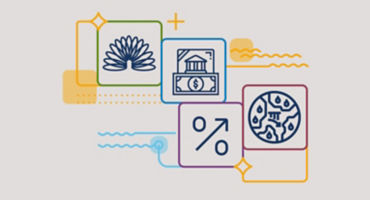- 環球投資及多元資產策略師
Skip to main content
- 基金中心
- 投資見解
- 關於我們
本刊所載見解反映作者於撰文時的觀點,其他團隊可能觀點各異,或會作出不同的投資決策。閣下投資的價值可能高於或低於初始投資時的水平。本刊所載第三方數據被視為可靠,惟概不保證其準確性。
僅提供英文版本
As of 14 March 2023
In a matter of days, the cumulative effect of US Federal Reserve (Fed) policy tightening has hit the US banking sector hard, beginning with the collapse of Silicon Valley Bank (SVB) on March 10.
Panicked depositors in several banks have since rushed to the exits, setting off a liquidity crisis and leaving some banks' capital positions in precarious shape. The Fed and the US Treasury have taken swift steps to help stabilize the banking system by providing liquidity and assuring impacted depositors that they will be "made whole." This past weekend, they unveiled several new facilities designed to ease the "liquidity crunch" and to prevent further bank runs.
However, growing investor concerns are sweeping the financial markets: Safe-haven assets have benefited, Fed rate-hike expectations have been all but extinguished, government bond yields are lower and credit spreads wider, and the US dollar (USD) has risen. Meanwhile, global equities are down, with small-cap stocks the big laggards so far.
The situation is evolving rapidly as we speak, as are the potential economic and market implications. At Wellington, we don't always agree with each other, but we vigorously debate the issues and ramifications. Here are some key points from our latest internal discussions, highlighted by a common theme that there is now a greater probability of a US recession in the near term. Many of us also think investors should consider pivoting to a "risk-management mode" that favors higher-quality assets.
In the near term, I expect risk-off dynamics to dominate and less risky assets to outperform. Financials and other sectors tied to the economic cycle will likely struggle the most. I also expect large-cap stocks to outperform smaller-cap stocks and growth-style equities to outperform value in the short term. China and other Asian markets tied to China's recovery are apt to outperform the US and Europe, in my view.
Longer term, I see investment opportunities. Notably, I think quality assets may still be rewarded over time — for example, large money-center banks that have ample capital and have been subject to stricter regulation than smaller banks. Also, some high-quality US fixed income assets may offer relatively attractive yields and total-return potential if the economy softens. A risk is that the Fed's additional liquidity succeeds in averting a full-blown financial crisis but fans the flames of inflation, thus requiring more Fed rate hikes down the line. This is another reason I suggest favoring quality.
My bottom line: Until this all subsides, proceed cautiously, and be prepared to follow the "higher for longer" investment playbook for inflation and rates in your long game.
The speed and magnitude of the Fed's "about-face" from easy to tight monetary policy was bound to expose firms caught on the wrong side of rising rates. That's precisely what's happening here, and with the broader financial system now caught up in the turmoil, systemic risks should not be taken lightly. However, the US banking system is generally strong, especially the large, well-capitalized banks, and US regulation is designed to deal with commercial bank failures. I believe the Fed and Treasury will respond decisively to avoid a worst-case outcome.

參考網站連結
相關投資見解

市場大舉拋售:合情合理抑或反應過激?
有何因素引發環球市場大跌?投資者又可作何部署?環球投資及多元資產策略師Nanette Abuhoff Jacobson分享其看法。(僅提供英文版)

選債智慧:是時候大放異彩
身處利率波動時期,固定收益投資者仍在尋求應對方案,而大額且相對靜態的信貸投資不再是理想對策。反之,靈活動態的投資方針更具潛力締造堅韌靠穩的總回報。


了解美國銀行界動盪事由
投資傳訊經理Jitu Naidu及Adam Norman闡述近期美國銀行倒閉詳情,並對其影響作一探討。(於2023年3月14日刊發)(僅提供英文版本)
矽谷銀行崩塌有何投資啟示?
矽谷銀行金融集團分崩離析,對投資部署的影響逐漸顯現,多元資產策略師Supriya Menon分享其最新見解。(於2023年3月14日刊發)(僅提供英文版本)

面對波動加劇、市場結構改變以至投資數據暴增,或須掌握更多工具方能遊刃其中,威靈頓投資主席Steve Klar分享其見解。
參考網站連結
相關投資見解
重要披露
在未有威靈頓投資管理明確書面批准的情況下,概不可複製或轉載本刊全部或任何部分內容。本文件僅供參考之用,並非任何人士要約或邀請認購威靈頓投資管理(盧森堡)SICAV基金III系列的股份。本文件所載資料不應被視為投資建議,亦非買賣任何股份之推介。基金投資不一定適合所有投資者。所載見解反映作者於撰文時的觀點,可予更改而不作另行通知。投資者於作出投資決定前,務請細閱基金及子基金的產品資料概要、基金招股章程及香港說明文件,以了解詳情(包括風險因素),其他有關文件包括年度及半年度財務報告。
© 2024 Morningstar, Inc。版權所有。本刊所載資訊:(1) 為晨星(Morningstar)專有;(2) 不得複製或分發;及(3) 概不保證屬準確、完整或及時。晨星及其內容提供者概不就使用相關資訊所引致的任何損害或損失負責。基金的Morningstar綜合星號評級(Overall Morningstar Rating)乃基於經風險調整回報,按三年、五年及十年(倘適用)評級的加權平均得出。過去業績並非將來表現的保證。
由威靈頓管理香港有限公司刊發。投資涉及風險。過去業績並不代表將來表現。本文件未經香港證券及期貨事務監察委員會審閱。